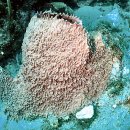Xestospongia muta (Schmidt, 1870)
Haplosclerida, Petrosiidae

| Common Name(s): |
Giant barrel sponge |
| Growth Form: |
Large barrel or tub up to at least ~1.5 m tall in deeper water; walls 2-15 cm thick. Usually a single barrel, but regenerating specimens in particular may develop up to about 4 short thick tubes. Smaller specimens conical or volcano-shaped with base wider than apex. |
| Surface: |
Vertically ridged, rugose, or with irregular or conical projections. Ridges range from shallow to deep and buttress-like. |
| Color: |
Exterior: red brown to grayish brown; reddish purple. Interior: paler tan. |
| Consistency: |
Brittle, incompressible, and crumbly. |
| Oscules: |
Large single terminal opening (>5 cm; may exceed 1 m). |
| Skeletal components (Spicules, fibers): |
Slightly curved rods with both ends pointed (oxeas) 300-435 x 11-18 μm and rods with both ends blunt (strongyles). No spongin. |
| Skeletal architecture: |
Exterior: Reticulation of similar spicule tracts (isotropic) surrounding large pores up to 200 μm across. Interior: meshwork of spicule tracts (30 – 300 μm in diameter) outlining rounded often cavernous meshes 120–1100 μm in diameter. Many loose spicules may be packed into dense masses that obscure meshwork. |
| Ecology: |
Common on reefs. Giant barrel sponges harbor dense populations of symbiotic bacteria, as well as the photosynthetic endosymbiont Aphanocapsa feldmanni, a chroococcoid cyanobacterium that provides this sponge’s color (Ruetzler 1990, Richelle-Maurer et al. 2003) and may transfer mineral nutrients (carbon, nitrogen, phosphorus) to the sponge, perhaps contributing to its growth (Wilkinson 1983, Thacker 2005, Gómez et al. 2004, Steindler et al. 2005). McMurray et al. (2008) reported a wide range in growth rate estimates, but suggested that the oldest Caribbean specimens might exceed 2,300 years old. |
|
Non-elastic, easily sliced tissues make X. muta susceptible to injury, and human or natural disturbances may completely or partially shear off the entire barrel, leaving behind only a small sliver of the base. X. muta can regenerate injured or lost tissue, and dislodged barrels can be artificially reattached (Schmahl 1999, Wulff 2006, McMurray & Pawlik 2008). X. muta is sturdy enough to withstand moderate disturbances, although severe damage may limit its regenerative ability. Following Hurricane Allen’s passage across Jamaica, Wulff (2006) observed that X. muta were able to regenerate bases, but large sheared-off fragments were unable to reattach and were lost. |
|
Barrel sponges exhibit two forms of bleaching in which symbiotic cyanobacteria are expelled. Nonfatal cyclic bleaching typically occurs in the Florida Keys in the fall, and sponges recover by spring. Fatal bleaching involves complete pigment loss, major tissue loss and death. Fishes consume such bleached tissues. A distinctive orange band separates completely and partially bleached areas (Vicente 1990, Dunlap & Pawlik 1998). The sponge also contains secondary metabolites that serve as predator deterrents and may compensate for the high levels of soluble protein, which make this sponge’s tissue a high-quality food source. However, some fishes such as wrasses (Thalassoma and Halichoeres), snappers (Ocyurus chrysurus), parrotfishes (Scarus) and sergeant majors (Abudefduf) still graze on X. muta (Chanas & Pawlik 1997, Dunlap & Pawlik 1998) |
|
Ritson-Williams et al. (2005) observed spawning south of Carrie Bow Cay, Belize, in late May 2004. Spawning was gonochoric, synchronous and lasted ~1 hr. Eggs sank to the middle of the sponge and nearby substrates, whereas sperm were released in a buoyant cloud. This is the same reproductive strategy reported for three Pacific Xestospongia. X. berguista, X. testudinaria, and X. exigua are all gonochoric, broadcast spawners, although gamete release occurred in October, November and January. [Partly contributed by S. Saelens.] |
| Distribution: |
South Florida and throughout the Caribbean over a wide depth range (4 m to at least 100 m). |
| Notes: |
Specimens fit well descriptions in the literature. Large variations in spicule thickness occur among Caribbean populations. |
| Similar species: |
Ircinia campana, Aplysina lacunosa. |
| Reference(s): |
van Soest (1980), Wilkinson (1983), Zea (1987), Ruetzler (1990), Vicente (1990), Chanas & Pawlik (1997), Dunlap & Pawlik (1998), Schmahl (1999), Richelle-Maurer et al. (2003), Gómez et al. (2004), Ritson-Williams et al. (2005), Steindler et al. (2005), Thacker (2005), Wulff (2006), McMurray et al. (2008) |
| Similar species: |

Aplysina cf. lacunosa |

Ircinia campana |
|
|











